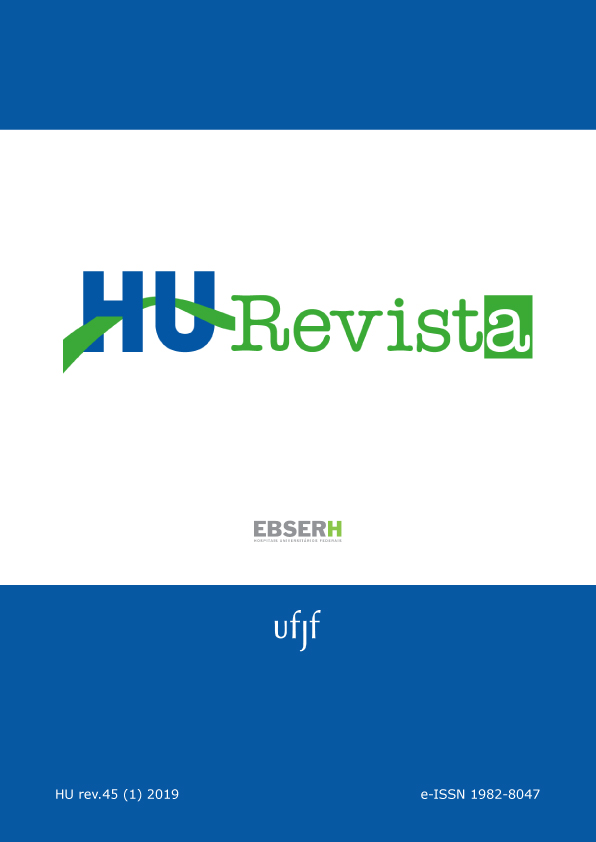Limitations in the daily life of people with chronic injury
DOI:
https://doi.org/10.34019/1982-8047.2019.v45.25798Keywords:
Nursing, Nursing care, Leg ulcer, Activities of daily living, Quality of life.Abstract
Introduction: The skin lesion is considered chronic when it exceeds six weeks to heal, being considered a public health problem, due to the psychological, social and economic impact for the patient, with high and increasing costs for the health system. Objective: to understand the limitations in the daily life of people with chronic injuries. Material and method: descriptive, exploratory, qualitative approach, carried out in a municipality of Minas Gerais with nine users of a basic health unit. The interview was used for the collection of data, which after transcription in full were submitted to Content Analysis in the thematic modality. Results: the individuals described that the pain made difficult the accomplishment of the domestic and occupational tasks. The limitation of living with the chronic lesion also ran into dependence to perform these activities. Social withdrawal was reported by participants due to odor and secretion, which resulted in low self-esteem. Conclusion: the lesions have repercussions on the psychoemotional spheres of the patients, with negative impacts on the quality of life. It demonstrates, therefore, the importance of the care given in the humanized host and in the sensitive listening throughout the treatment.
Downloads
References
Lara MO, Júnior ACP, Pinto JSF; Vieira NF, Wichr P. Significado da ferida para portadores de úlceras crônicas. Cogitare enferm. 2011; 16(3):471-7.
Peart J. Influence of psychosocial factors on coping and living with a venous leg ulcer. Br J Community Nurs. 2015; Suppl Community Wound Care:S21-2, S24, S26-7.
Silva MH, Jesus MCP, Merighi MAB, Oliveira DM, Biscotto, Silva GPS. O cotidiano do homem que convive com a úlcera venosa crônica: estudo fenomenológico. Rev Gaúcha Enferm. 2013;34(3):95-101.
Riegel B, Jaarsma T, Strömberg A. A Middle-range theory of self-care of chronic illness. Adv Nurs Sci. 2012;35(3):194-204.
Conselho Federal de Enfermagem (BR). Resolução nº 567, de 29 de janeiro de 2018. Regulamenta a atuação da Equipe de Enfermagem no Cuidado aos pacientes com feridas. 2018. Diário Oficial da União, seção 1, número 26, p.112. Disponível em: http://www.cofen.gov.br/resolucao-cofen-no-567-2018_60340.html
Fonseca C, Franco T, Ramos A, Silva C. A pessoa com úlcera de perna, intervenção estruturada dos cuidados de enfermagem: revisão sistemática da literatura. Rev Esc Enferm USP 2012; 46(2):480-6.
Silva DS, Hahn GV. Cuidados com úlceras venosas: realidade do Brasil e Portugal. Rev Enferm UFSM. 2012;2(2):330-338.
Conselho Federal de Enfermagem (COFEN). Resolução n.º 358/2009, de 15 de outubro de 2009. Dispõe sobre a Sistematização da Assistência de Enfermagem e a implementação do Processo de enfermagem em ambientes, públicos ou privados, em que ocorre o cuidado profissional de Enfermagem, e dá outras providências. [internet] 2009 [acesso em 2015 mar 12]. Disponível: http://www.cofen.gov.br/resoluo-cofen-3582009_4384.html.
Conselho Regional de Enfermagem de São Paulo. Processo de Enfermagem: guia para a prática. São Paulo; COREN-SP; 2015.
Macedo MML, Rodrigues RN, Cortez DN, Lanza FM, Gontijo TL. Abordagem ao portador de úlceras crônicas no município de Divinópolis-MG. Rev APS. 2013; 16(4): 474-78.
Minayo MCS. Análise qualitativa: teoria, passos e fidedignidade. Ciênc. saúde coletiva 2012; 17(3): 621-626.
Bardin L. Análise de conteúdo. 4ªed. Lisboa; Edições 70; 2011.
Rodrigues ALS, Oliveira BGRB, Futuro DO, Secoli SR. Efetividade do gel de papaína no tratamento de úlceras venosas: ensaio clínico randomizado. Rev Latino-Am Enfermagem. 2015;23(3):458-65.
Kouris A, Christodoulou C, Efstathiou V, Chatzimichail I, Zakopoulou N, Zouridaki E. Quality of life in Greek family members living with leg ulcer patients. Wound Repair Regen. 2015; 23(5): 778-80.
Budó MLD, Durgante VL, Rizzatti SJS, Silva DC, Gewehr M, Farão EMD. Úlcera venosa, índice tornozelo braço e dor nas pessoas com úlcera venosa em assistência no ambulatório de angiologia. R. Enferm. Cent. O. Min. 2015; 5(3):1794-1804.
Edwards H; Finlayson K; Courtney M; Graves N; Gibb M; Parker C. Health service pathways for patients with chronic leg ulcers: identifying effective pathways for facilitation of evidence based wound care. BMC Health Serv Res. 2013; 13:86.
Dias TYAF, Costa IKF, Melo MDM, Torres SMSGSO, Maia EMC, Torres GV. Avaliação da qualidade de vida de pacientes com e sem úlcera venosa. Rev. Latino-Am. Enfermagem. 2014;22(4):576-81.
Mooij MC, Huisman LC. Chronic leg ulcer: does a patient always get a correct diagnosis and adequate treatment? Phlebology. 2016;31(1 Suppl):68-73.
House SL. Psychological distress and its impact on wound healing: an integrative review. J Wound Ostomy Continence Nurs. 2015; 42(1):38-41.
Jesus PBR, Brandão ES, Silva CRL. Cuidados de enfermagem aos clientes com úlceras venosas uma revisão integrativa da literatura. J. res.: fundam. care. online 2015; 7(2):2639-2648.
Downloads
Published
How to Cite
Issue
Section
License
Cessão de Primeira Publicação à HU Revista
Os autores mantém todos os direitos autorais sobre a publicação, sem restrições, e concedem à HU Revista o direito de primeira publicação, com o trabalho licenciado sob a Licença Creative Commons Attribution que permite o compartilhamento irrestrito do trabalho, com reconhecimento da autoria e crédito pela citação de publicação inicial nesta revista, referenciando inclusive seu DOI.









